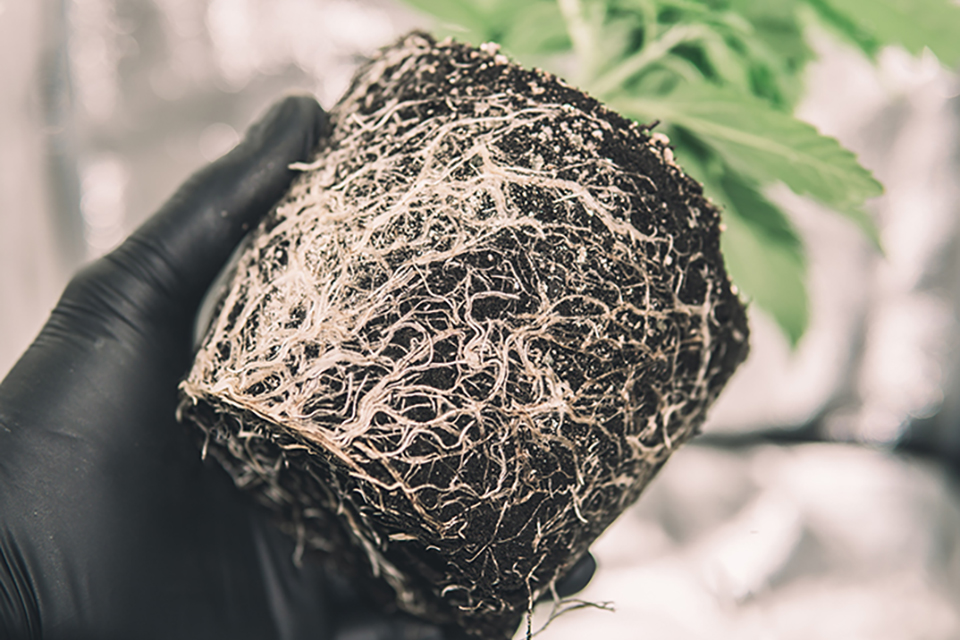
Pythium is a destructive parasitic fungus that can lead to the rotting of the plant’s roots.
Since these species are a common threat to cannabis cultivation, early detection and prompt action are crucial to ensuring the health and vitality of your cannabis plants.
Knowing how to deal with this threat can help you prevent root damage and achieve the expected yield.
Let’s discuss how to identify Pythium in cannabis plants, explore preventive measures, and go over effective treatment options.
Identifying Pythium in Cannabis Plants
Recognizing symptoms of Pythium infection is critical in stopping the disease from advancing. They include:
- Wilting and yellowing leaves: Pythium can cause the leaves of cannabis plants to wilt and turn yellow, even if the soil is moist.
- Stunted growth: Infected plants may exhibit slowed or stunted growth, with smaller and underdeveloped leaves and stems.
- Root discoloration: Pythium attacks the roots, leading to a brown or black discoloration.
- Root rot: As the disease progresses, the roots can become soft and mushy, eventually leading to root rot. Infected roots may emit a foul order and easily break when touched.
- Poor nutrient uptake: Due to the damage to the roots, affected plants may show signs of nutrient deficiencies, even if the nutrients are present in the soil.
- Damping-off: Pythium can cause damping-off in the early stages, where seedlings suddenly collapse and die without apparent cause.
- General decline: Infected plants may exhibit an overall decline in health, with reduced vigor, lower yields, and increased susceptibility to other diseases and pests.
It is important to note that these symptoms can also indicate other issues, so it is essential to properly diagnose the problem before starting the treatment.
Preventive Measures for Pythium
Preventing Pythium in cannabis plants is crucial to maintaining their health and productivity. Here are some preventive methods to consider:
- Proper sanitation: Start with clean equipment, tools, and growing containers. Disinfect them before use to eliminate any potential sources of Pythium contamination.
- High-quality planting media: Use well-draining planting media that allows excess water to drain away effectively. Avoid overwatering, as excessive moisture can create a favorable environment for Pythium growth.
- Adequate air circulation: Ensure proper air circulation in the growing area to help prevent excessive humidity and maintain a drier environment. You can achieve this through the use of fans or ventilation systems.
- Proper watering practices: Water the plants at the base, avoiding foliage wetting. Overwatering can create conditions that favor Pythium growth, so water cannabis plants only when necessary and allow the soil to dry out between waterings.
- Temperature and humidity control: Maintain optimal temperature and humidity levels in the growing area. Pythium thrives in warm and humid conditions, so keeping temperatures around 70-80°F and humidity levels below 60% can help reduce the risk of Pythium development.
- Beneficial microbes and biofungicides: Introduce beneficial microbes, such as Trichoderma spp., into the growing media. These beneficial organisms can help suppress Pythium growth. Use biofungicides containing Bacillus subtilis or other natural fungicides as prevention against Pythium.
- Avoidance of plant stress: Stressed plants are more susceptible to Pythium infections. Provide proper nutrition, maintain appropriate light levels, and address any other factors that may cause stress.
Regularly inspect plants for any signs of Pythium or other diseases. Early detection allows for prompt action and reduces the risk of spread.
Treating Pythium in Cannabis Plants
Organic and chemical treatments are available to combat Pythium. Introduce organic options such as beneficial Trichoderma fungi or Bacillus Subtilis bacteria to destroy Pythium in your plant. In addition, chemical fungicides like Mefenoxam and Metalaxyl-M can also be effective in treating infected plants.
To eradicate Pythium from infected plants, remove and destroy the affected parts. Clean the growing area thoroughly to prevent re-infection. Handle the healthy plants last to minimize the spread of spores.
Maintaining Healthy Root Systems
Healthy roots are more resistant to Pythium infections and can better absorb nutrients and water, enhancing plant growth and productivity.
To promote robust root growth and vitality, ensure proper watering practices, avoiding overwatering or waterlogged conditions. Use well-draining planting media and provide adequate air circulation. Supplement with beneficial microbes to enhance root health and prevent Pythium growth.
Provide proper nutrition, maintain optimal temperature and humidity, and avoid plant stress.
Avoiding Root Rot Problems and Growing a Healthy Crop
Dealing with Pythium in cannabis plants can be challenging, but a proactive approach to identifying symptoms, maintaining optimal growing conditions, and applying effective treatment can save your crop. The key is not to panic at the first sign of trouble but instead take immediate action to rectify the problem.
Remember, prevention is your best ally. Choose the right seeds, maintain proper watering practices, and foster healthy root systems. Shop for high-quality, disease-resistant seeds at kindseed.com and embark on a journey of successful cannabis cultivation. With vigilance and proactivity, you can ensure your cannabis plants thrive, free of Pythium.



